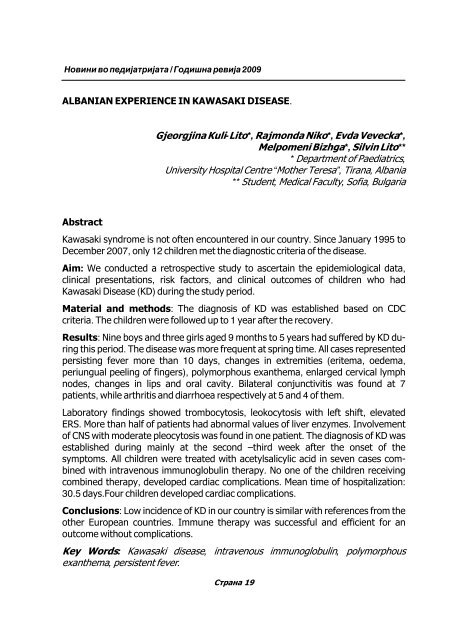Conduct disorder
Conduct disorder
Conduct disorder
Create successful ePaper yourself
Turn your PDF publications into a flip-book with our unique Google optimized e-Paper software.
Novini vo pedijatrijata / Godi[na revija 2009<br />
ALBANIAN EXPERIENCE IN KAWASAKI DISEASE.<br />
Gjeorgjina Kuli-Lito*, Rajmonda Niko*, Evda Vevecka*,<br />
Melpomeni Bizhga*, Silvin Lito**<br />
* Department of Paediatrics,<br />
University Hospital Centre “Mother Teresa”, Tirana, Albania<br />
** Student, Medical Faculty, Sofia, Bulgaria<br />
Abstract<br />
Kawasaki syndrome is not often encountered in our country. Since January 1995 to<br />
December 2007, only 12 children met the diagnostic criteria of the disease.<br />
Aim: We conducted a retrospective study to ascertain the epidemiological data,<br />
clinical presentations, risk factors, and clinical outcomes of children who had<br />
Kawasaki Disease (KD) during the study period.<br />
Material and methods: The diagnosis of KD was established based on CDC<br />
criteria. The children were followed up to 1 year after the recovery.<br />
Results: Nine boys and three girls aged 9 months to 5 years had suffered by KD during<br />
this period. The disease was more frequent at spring time. All cases represented<br />
persisting fever more than 10 days, changes in extremities (eritema, oedema,<br />
periungual peeling of fingers), polymorphous exanthema, enlarged cervical lymph<br />
nodes, changes in lips and oral cavity. Bilateral conjunctivitis was found at 7<br />
patients, while arthritis and diarrhoea respectively at 5 and 4 of them.<br />
Laboratory findings showed trombocytosis, leokocytosis with left shift, elevated<br />
ERS. More than half of patients had abnormal values of liver enzymes. Involvement<br />
of CNS with moderate pleocytosis was found in one patient. The diagnosis of KD was<br />
established during mainly at the second –third week after the onset of the<br />
symptoms. All children were treated with acetylsalicylic acid in seven cases combined<br />
with intravenous immunoglobulin therapy. No one of the children receiving<br />
combined therapy, developed cardiac complications. Mean time of hospitalization:<br />
30.5 days.Four children developed cardiac complications.<br />
Conclusions: Low incidence of KD in our country is similar with references from the<br />
other European countries. Immune therapy was successful and efficient for an<br />
outcome without complications.<br />
Key Words: Kawasaki disease, intravenous immunoglobulin, polymorphous<br />
exanthema, persistent fever.<br />
Страна 19


